Abstract
Although exogenous phosphatidic acid (PA) has been shown to promote insulin release, the effects of endogenous PA on endocrine function are largely unexplored. In order to generate PA in situ, intact adult-rat islets were treated with exogenous phospholipases of the D type (PLD), and their effects on phospholipid metabolism and on insulin release were studied in parallel. Chromatographically purified PLD from Streptomyces chromofuscus stimulated the accumulation of PA in [14C]arachidonate- or [14C]myristate-prelabelled islets, and also promoted insulin secretion over an identical concentration range. During 30 min incubations, insulin release correlated closely with the accumulation of [14C]arachidonate-labelled PA (r2 = 0.98; P less than 0.01) or [14C]myristate-labelled PA (r2 = 0.97; P less than 0.01). Similar effects were seen both in freshly isolated and in overnight-cultured intact islets. In contrast, PLDs (from cabbage or peanut) which do not support phospholipid hydrolysis at the pH of the extracellular medium also did not promote insulin release. The effects on secretion of the active PLD preparation were inhibited by modest cooling (to 30 degrees C); dantrolene or Co2+ also inhibited PLD-induced secretion without decreasing PLD-induced PA formation. Additionally, the removal of PLD left the subsequent islet responsiveness to glucose intact, further supporting an exocytotic non-toxic mechanism. PLD-induced insulin release did not appear to require influx of extracellular Ca2+, nor could the activation of protein kinase C clearly be implicated. During incubations of 30 min, PLD selectively generated PA; however, more prolonged incubations (60 min) also led to production of some diacyglycerol and free arachidonic acid concomitant with progressive insulin release. These data suggest that PLD activation has both rapid and direct effects (via PA) and more delayed, secondary, effects (via other effects of PA or the generation of other lipid signals). Taken in conjunction with our demonstration that pancreatic islets contain an endogenous PLD which generates PA [Dunlop & Metz (1989) Biochem. Biophys. Res. Commun. 163, 922-928], these studies provide evidence suggesting that PLD activation (and possibly other pathways leading to PA formation) could play a role in stimulus-secretion coupling in pancreatic islets.
Full text
PDF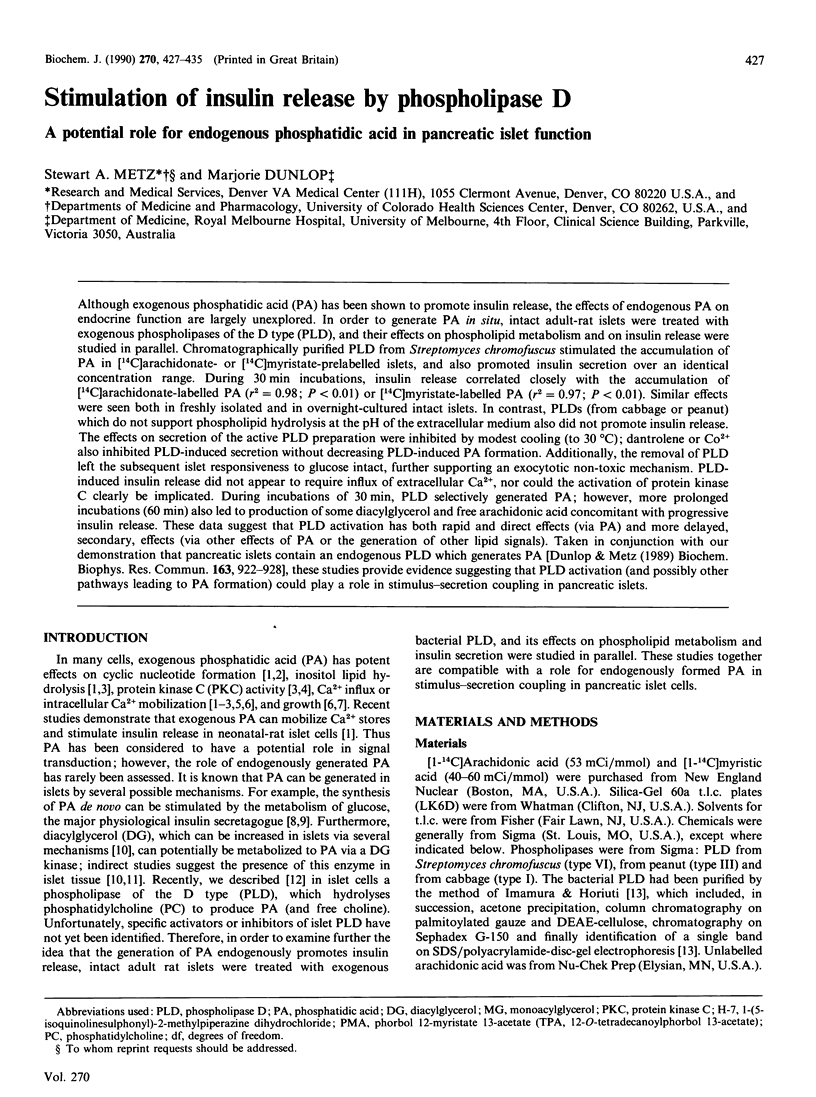
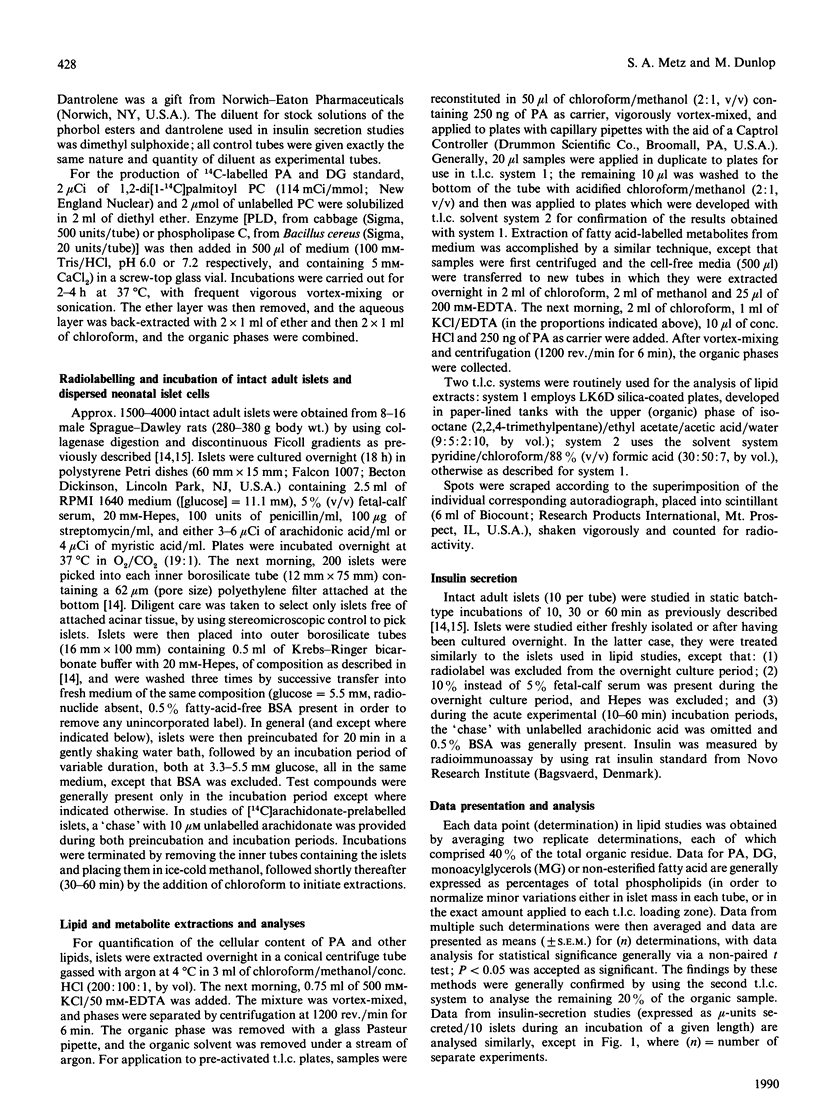
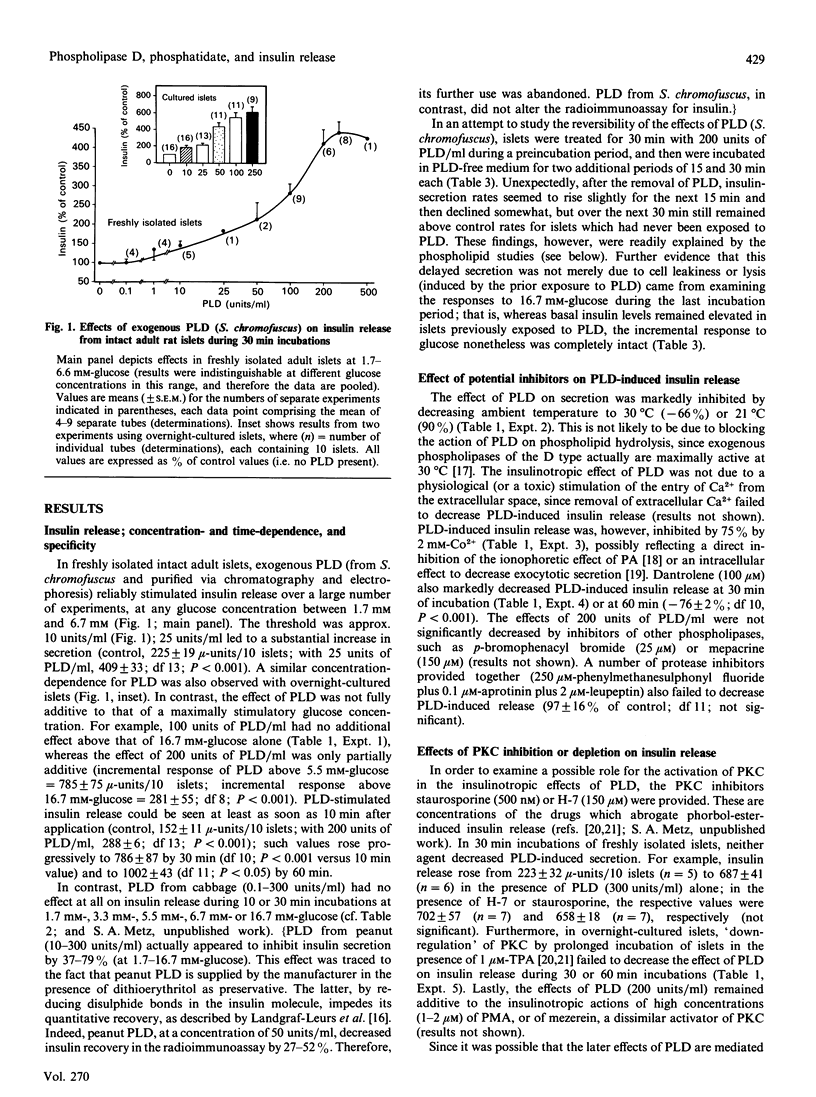
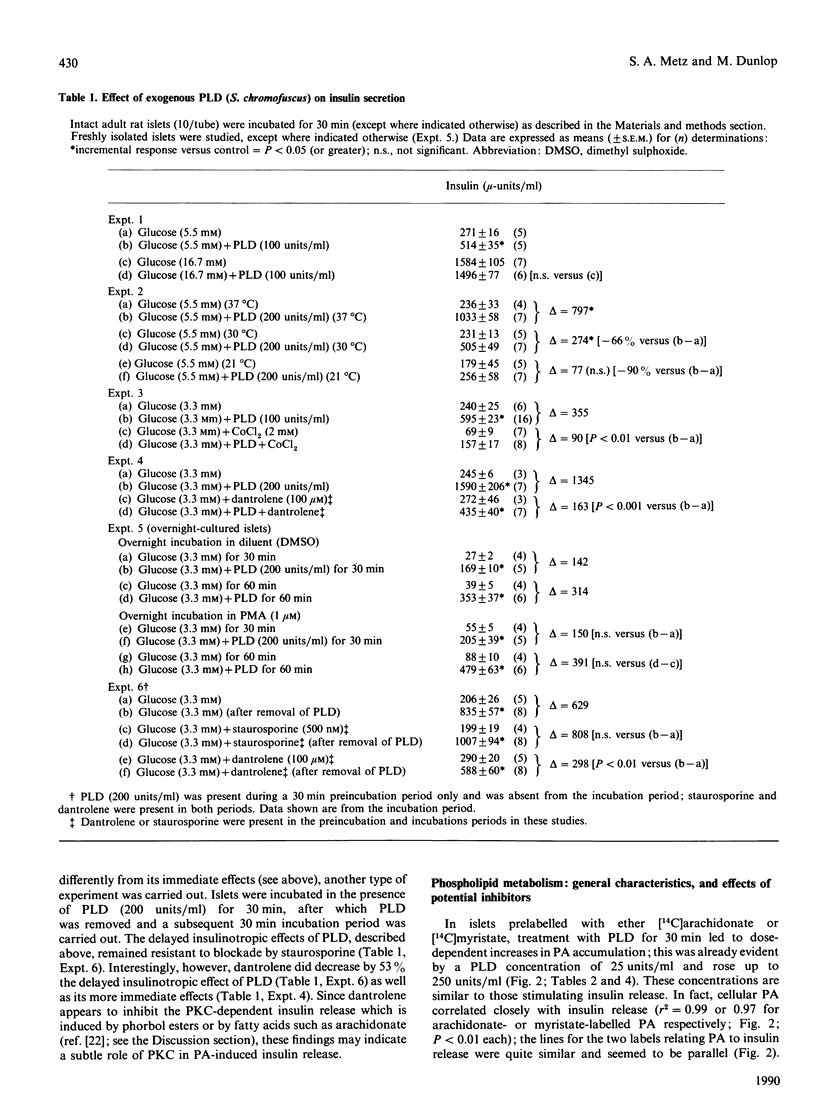
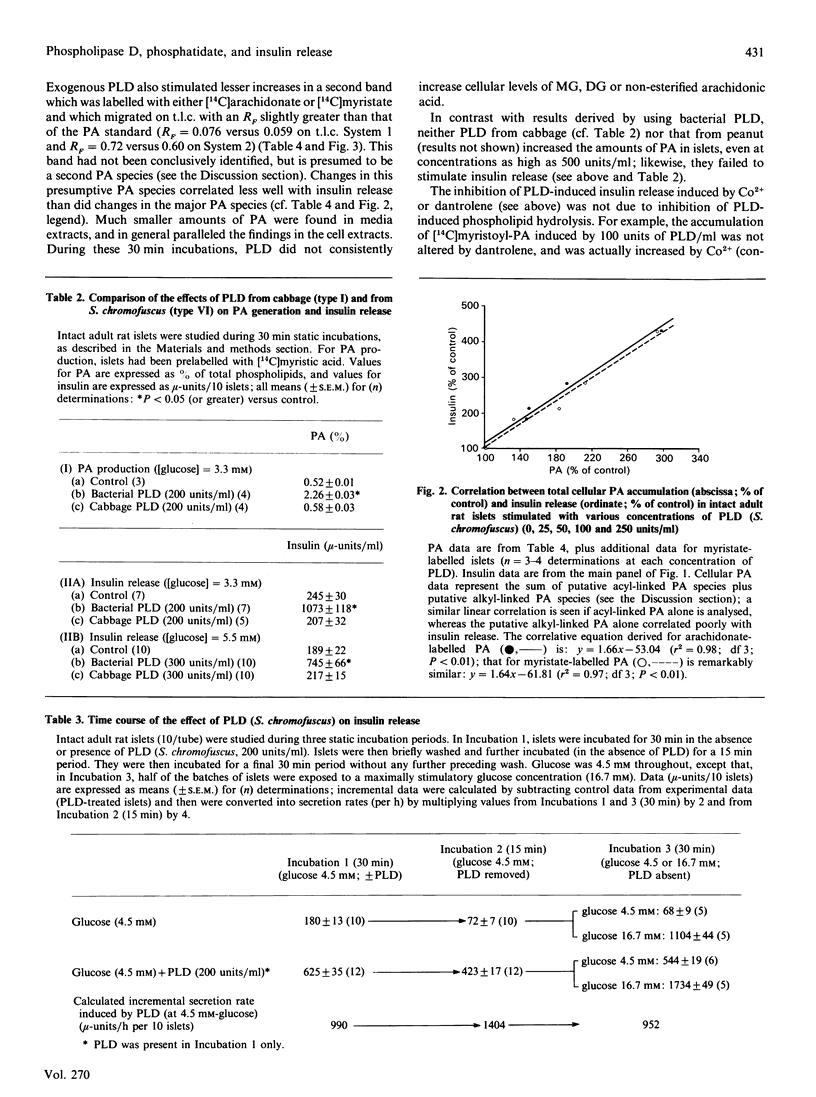
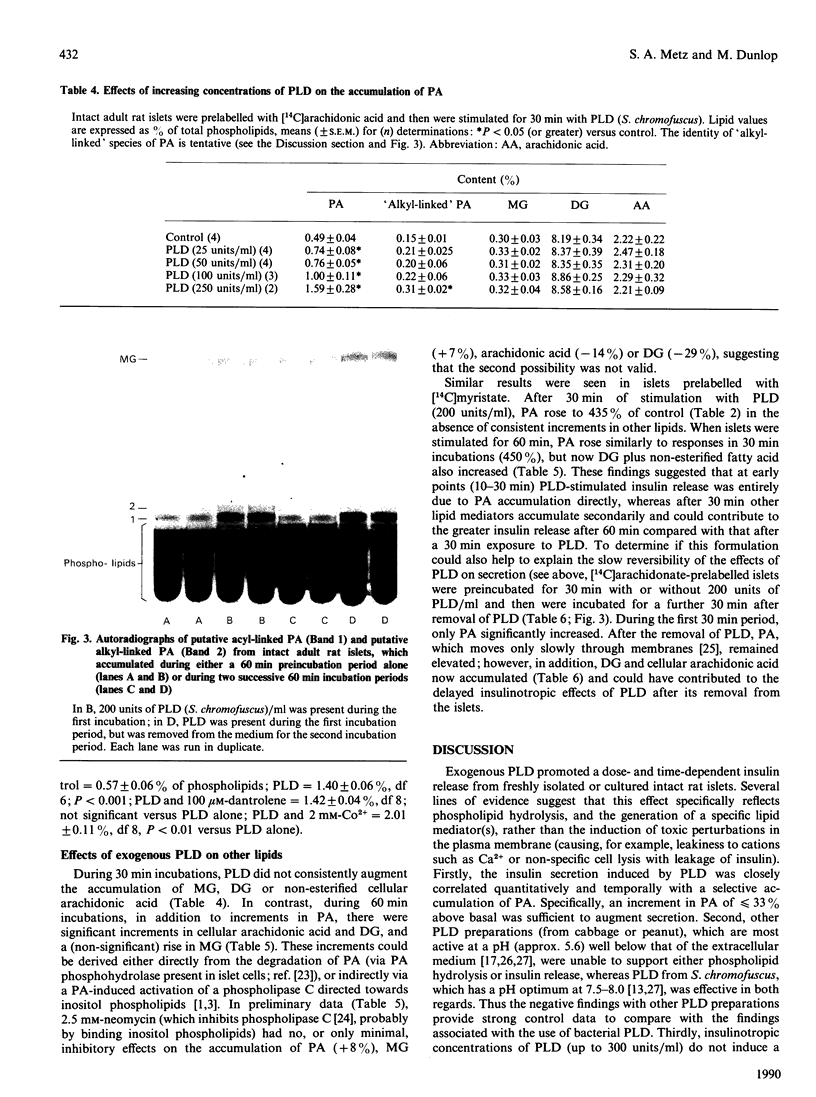
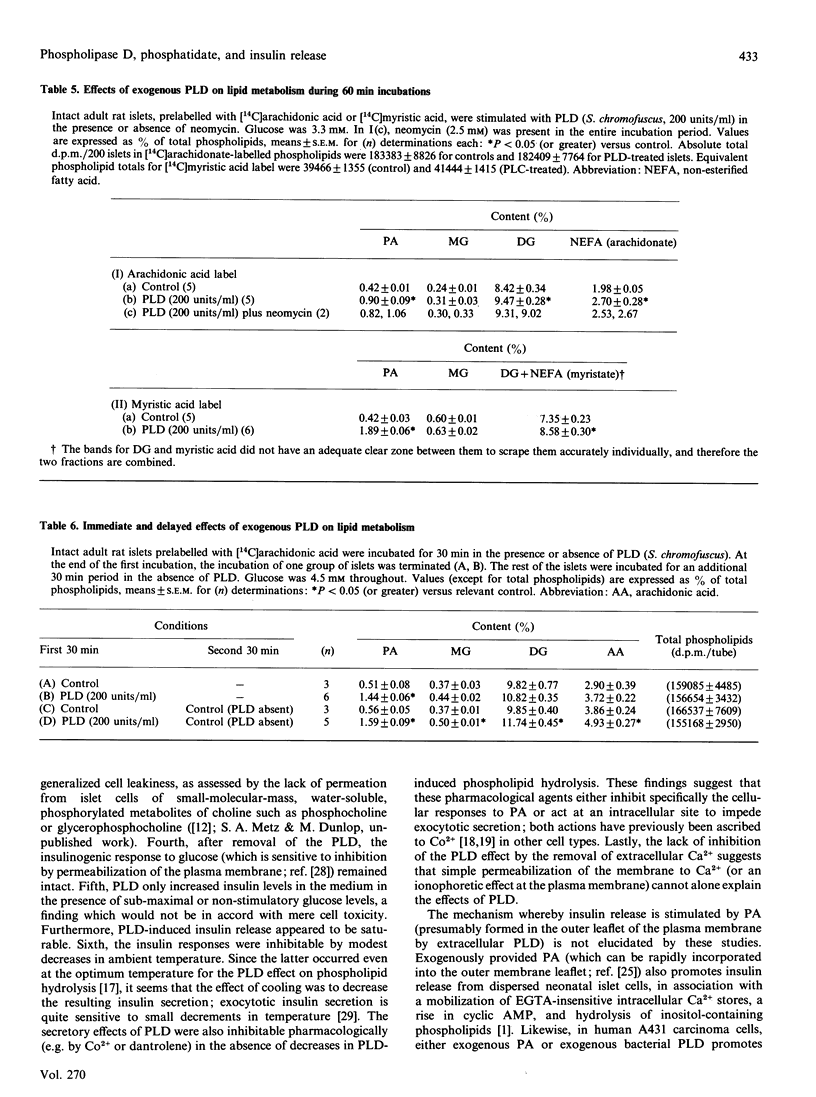
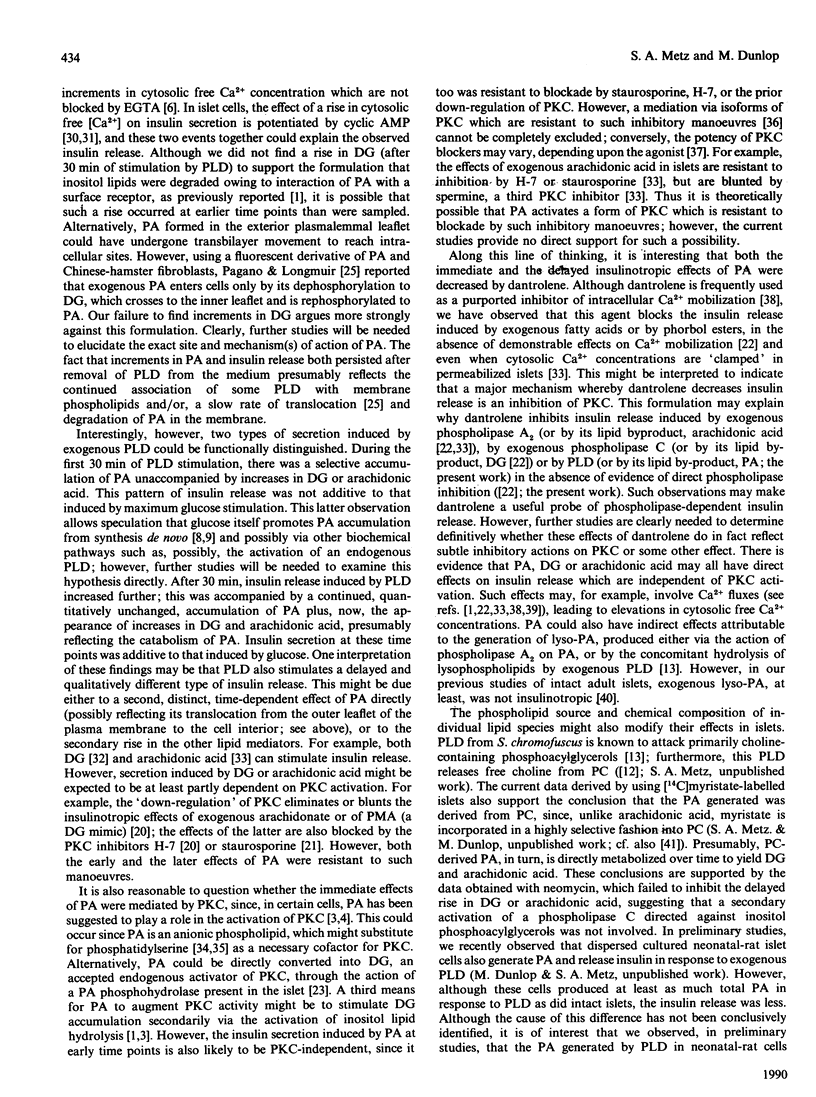
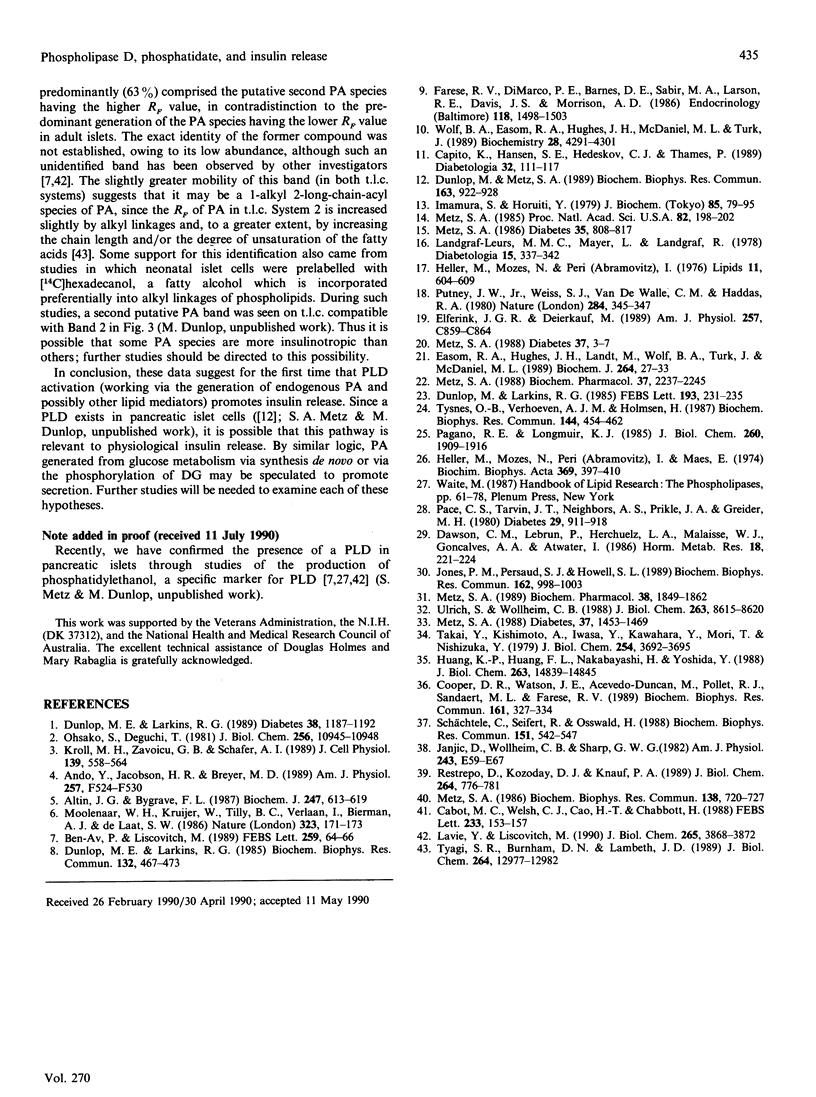
Images in this article
Selected References
These references are in PubMed. This may not be the complete list of references from this article.
- Altin J. G., Bygrave F. L. Phosphatidic acid and arachidonic acid each interact synergistically with glucagon to stimulate Ca2+ influx in the perfused rat liver. Biochem J. 1987 Nov 1;247(3):613–619. doi: 10.1042/bj2470613. [DOI] [PMC free article] [PubMed] [Google Scholar]
- Ando Y., Jacobson H. R., Breyer M. D. Phosphatidates inhibit vasopressin-induced water transport via protein kinase C activation. Am J Physiol. 1989 Oct;257(4 Pt 2):F524–F530. doi: 10.1152/ajprenal.1989.257.4.F524. [DOI] [PubMed] [Google Scholar]
- Ben-Av P., Liscovitch M. Phospholipase D activation by the mitogens platelet-derived growth factor and 12-O-tetradecanoylphorbol 13-acetate in NIH-3T3 cells. FEBS Lett. 1989 Dec 18;259(1):64–66. doi: 10.1016/0014-5793(89)81495-4. [DOI] [PubMed] [Google Scholar]
- Cabot M. C., Welsh C. J., Cao H. T., Chabbott H. The phosphatidylcholine pathway of diacylglycerol formation stimulated by phorbol diesters occurs via phospholipase D activation. FEBS Lett. 1988 Jun 6;233(1):153–157. doi: 10.1016/0014-5793(88)81374-7. [DOI] [PubMed] [Google Scholar]
- Capito K., Hansen S. E., Hedeskov C. J., Thams P. Effect of diacylglycerol lipase inhibitor RHC 80267 on pancreatic mouse islet metabolism and insulin secretion. Diabetologia. 1989 Feb;32(2):111–117. doi: 10.1007/BF00505183. [DOI] [PubMed] [Google Scholar]
- Cooper D. R., Watson J. E., Acevedo-Duncan M., Pollet R. J., Standaert M. L., Farese R. V. Retention of specific protein kinase C isozymes following chronic phorbol ester treatment in BC3H-1 myocytes. Biochem Biophys Res Commun. 1989 May 30;161(1):327–334. doi: 10.1016/0006-291x(89)91600-8. [DOI] [PubMed] [Google Scholar]
- Dawson C. M., Lebrun P., Herchuelz A., Malaisse W. J., Gonçalves A. A., Atwater I. Effect of temperature upon potassium-stimulated insulin release and calcium entry in mouse and rat islets. Horm Metab Res. 1986 Apr;18(4):221–224. doi: 10.1055/s-2007-1012278. [DOI] [PubMed] [Google Scholar]
- Dunlop M. E., Larkins R. G. Effects of phosphatidic acid on islet cell phosphoinositide hydrolysis, Ca2+, and adenylate cyclase. Diabetes. 1989 Sep;38(9):1187–1192. doi: 10.2337/diab.38.9.1187. [DOI] [PubMed] [Google Scholar]
- Dunlop M. E., Larkins R. G. Pancreatic islets synthesize phospholipids de novo from glucose via acyl-dihydroxyacetone phosphate. Biochem Biophys Res Commun. 1985 Oct 30;132(2):467–473. doi: 10.1016/0006-291x(85)91157-x. [DOI] [PubMed] [Google Scholar]
- Dunlop M., Larkins R. G. Presence of membrane-associated phosphatidate phosphohydrolase activity in cultured islets and its stimulation by glucose. FEBS Lett. 1985 Dec 2;193(2):231–235. doi: 10.1016/0014-5793(85)80158-7. [DOI] [PubMed] [Google Scholar]
- Dunlop M., Metz S. A. A phospholipase D-like mechanism in pancreatic islet cells: stimulation by calcium ionophore, phorbol ester and sodium fluoride. Biochem Biophys Res Commun. 1989 Sep 15;163(2):922–928. doi: 10.1016/0006-291x(89)92310-3. [DOI] [PubMed] [Google Scholar]
- Easom R. A., Hughes J. H., Landt M., Wolf B. A., Turk J., McDaniel M. L. Comparison of effects of phorbol esters and glucose on protein kinase C activation and insulin secretion in pancreatic islets. Biochem J. 1989 Nov 15;264(1):27–33. doi: 10.1042/bj2640027. [DOI] [PMC free article] [PubMed] [Google Scholar]
- Elferink J. G., Deierkauf M. Suppressive action of cobalt on exocytosis and respiratory burst in neutrophils. Am J Physiol. 1989 Nov;257(5 Pt 1):C859–C864. doi: 10.1152/ajpcell.1989.257.5.C859. [DOI] [PubMed] [Google Scholar]
- Farese R. V., DiMarco P. E., Barnes D. E., Sabir M. A., Larson R. E., Davis J. S., Morrison A. D. Rapid glucose-dependent increases in phosphatidic acid and phosphoinositides in rat pancreatic islets. Endocrinology. 1986 Apr;118(4):1498–1503. doi: 10.1210/endo-118-4-1498. [DOI] [PubMed] [Google Scholar]
- Heller M., Mozes N., Peri I. Interactions of phospholipase D with 1,2 diacyl-sn-glycerol-3-phosphorylcholine, dodecylsulfate, and Ca2+. Lipids. 1976 Aug;11(8):604–609. doi: 10.1007/BF02532873. [DOI] [PubMed] [Google Scholar]
- Huang K. P., Huang F. L., Nakabayashi H., Yoshida Y. Biochemical characterization of rat brain protein kinase C isozymes. J Biol Chem. 1988 Oct 15;263(29):14839–14845. [PubMed] [Google Scholar]
- Imamura S., Horiuti Y. Purification of Streptomyces chromofuscus phospholipase D by hydrophobic affinity chromatography on palmitoyl cellulose. J Biochem. 1979 Jan;85(1):79–95. doi: 10.1093/oxfordjournals.jbchem.a132334. [DOI] [PubMed] [Google Scholar]
- Janjic D., Wollheim C. B., Sharp G. W. Selective inhibition of glucose-stimulated insulin release by dantrolene. Am J Physiol. 1982 Jul;243(1):E59–E67. doi: 10.1152/ajpendo.1982.243.1.E59. [DOI] [PubMed] [Google Scholar]
- Jones P. M., Persaud S. J., Howell S. L. Time-course of Ca2+-induced insulin secretion from perifused, electrically permeabilised islets of Langerhans: effects of cAMP and a phorbol ester. Biochem Biophys Res Commun. 1989 Aug 15;162(3):998–1003. doi: 10.1016/0006-291x(89)90772-9. [DOI] [PubMed] [Google Scholar]
- Kroll M. H., Zavoico G. B., Schafer A. I. Second messenger function of phosphatidic acid in platelet activation. J Cell Physiol. 1989 Jun;139(3):558–564. doi: 10.1002/jcp.1041390315. [DOI] [PubMed] [Google Scholar]
- Landgraf-Leurs M. M., Mayer L., Landgraf R. Sulphydryl requirement for insulin release from the perfused pancreas. Studies with ethacrynic acid and dithiothreitol. Diabetologia. 1978 Oct;15(4):337–342. doi: 10.1007/BF03160999. [DOI] [PubMed] [Google Scholar]
- Lavie Y., Liscovitch M. Activation of phospholipase D by sphingoid bases in NG108-15 neural-derived cells. J Biol Chem. 1990 Mar 5;265(7):3868–3872. [PubMed] [Google Scholar]
- Metz S. A. Blockade by lipoxygenase inhibitors of Ca2+-dependent insulin secretion from permeabilized rat islets. A molecular mechanism distinct from that of alpha 2-adrenergic agonists. Biochem Pharmacol. 1989 Jun 1;38(11):1849–1862. doi: 10.1016/0006-2952(89)90421-8. [DOI] [PubMed] [Google Scholar]
- Metz S. A. Dantrolene-induced inhibition of insulin release. A mechanism independent of effects on calcium fluxes. Biochem Pharmacol. 1988 Jun 1;37(11):2237–2245. doi: 10.1016/0006-2952(88)90587-4. [DOI] [PubMed] [Google Scholar]
- Metz S. A. Ether-linked lysophospholipids initiate insulin secretion. Lysophospholipids may mediate effects of phospholipase A2 activation on hormone release. Diabetes. 1986 Jul;35(7):808–817. doi: 10.2337/diab.35.7.808. [DOI] [PubMed] [Google Scholar]
- Metz S. A. Exogenous arachidonic acid promotes insulin release from intact or permeabilized rat islets by dual mechanisms. Putative activation of Ca2+ mobilization and protein kinase C. Diabetes. 1988 Nov;37(11):1453–1469. doi: 10.2337/diab.37.11.1453. [DOI] [PubMed] [Google Scholar]
- Metz S. A. Glucose increases the synthesis of lipoxygenase-mediated metabolites of arachidonic acid in intact rat islets. Proc Natl Acad Sci U S A. 1985 Jan;82(1):198–202. doi: 10.1073/pnas.82.1.198. [DOI] [PMC free article] [PubMed] [Google Scholar]
- Metz S. A. Lysophosphatidylinositol, but not lysophosphatidic acid, stimulates insulin release. A possible role for phospholipase A2 but not de novo synthesis of lysophospholipid in pancreatic islet function. Biochem Biophys Res Commun. 1986 Jul 31;138(2):720–727. doi: 10.1016/s0006-291x(86)80556-3. [DOI] [PubMed] [Google Scholar]
- Metz S. A. Perspectives in diabetes. Is protein kinase C required for physiologic insulin release? Diabetes. 1988 Jan;37(1):3–7. doi: 10.2337/diab.37.1.3. [DOI] [PubMed] [Google Scholar]
- Moolenaar W. H., Kruijer W., Tilly B. C., Verlaan I., Bierman A. J., de Laat S. W. Growth factor-like action of phosphatidic acid. Nature. 1986 Sep 11;323(6084):171–173. doi: 10.1038/323171a0. [DOI] [PubMed] [Google Scholar]
- Ohsako S., Deguchi T. Stimulation of phosphatidic acid of calcium influx and cyclic GMP synthesis in neuroblastoma cells. J Biol Chem. 1981 Nov 10;256(21):10945–10948. [PubMed] [Google Scholar]
- Pace C. S., Tarvin J. T., Neighbors A. S., Pirkle J. A., Greider M. H. Use of a high voltage technique to determine the molecular requirements for exocytosis in islet cells. Diabetes. 1980 Nov;29(11):911–918. doi: 10.2337/diab.29.11.911. [DOI] [PubMed] [Google Scholar]
- Pagano R. E., Longmuir K. J. Phosphorylation, transbilayer movement, and facilitated intracellular transport of diacylglycerol are involved in the uptake of a fluorescent analog of phosphatidic acid by cultured fibroblasts. J Biol Chem. 1985 Feb 10;260(3):1909–1916. [PubMed] [Google Scholar]
- Putney J. W., Jr, Weiss S. J., Van De Walle C. M., Haddas R. A. Is phosphatidic acid a calcium ionophore under neurohumoral control? Nature. 1980 Mar 27;284(5754):345–347. doi: 10.1038/284345a0. [DOI] [PubMed] [Google Scholar]
- Restrepo D., Kozody D. J., Knauf P. A. Synthetic diacylglycerols trigger an increase of intracellular free calcium in promyelocytic HL60 cells. J Biol Chem. 1989 Jan 15;264(2):776–781. [PubMed] [Google Scholar]
- Schächtele C., Seifert R., Osswald H. Stimulus-dependent inhibition of platelet aggregation by the protein kinase C inhibitors polymyxin B, H-7 and staurosporine. Biochem Biophys Res Commun. 1988 Feb 29;151(1):542–547. doi: 10.1016/0006-291x(88)90628-6. [DOI] [PubMed] [Google Scholar]
- Takai Y., Kishimoto A., Iwasa Y., Kawahara Y., Mori T., Nishizuka Y. Calcium-dependent activation of a multifunctional protein kinase by membrane phospholipids. J Biol Chem. 1979 May 25;254(10):3692–3695. [PubMed] [Google Scholar]
- Tyagi S. R., Burnham D. N., Lambeth J. D. On the biological occurrence and regulation of 1-acyl and 1-O-alkyl-diradylglycerols in human neutrophils. Selective destruction of diacyl species using Rhizopus lipase. J Biol Chem. 1989 Aug 5;264(22):12977–12982. [PubMed] [Google Scholar]
- Tysnes O. B., Verhoeven A. J., Holmsen H. Neomycin inhibits agonist-stimulated polyphosphoinositide metabolism and responses in human platelets. Biochem Biophys Res Commun. 1987 Apr 14;144(1):454–462. doi: 10.1016/s0006-291x(87)80531-4. [DOI] [PubMed] [Google Scholar]
- Ullrich S., Wollheim C. B. GTP-dependent inhibition of insulin secretion by epinephrine in permeabilized RINm5F cells. Lack of correlation between insulin secretion and cyclic AMP levels. J Biol Chem. 1988 Jun 25;263(18):8615–8620. [PubMed] [Google Scholar]
- Wolf B. A., Easom R. A., Hughes J. H., McDaniel M. L., Turk J. Secretagogue-induced diacylglycerol accumulation in isolated pancreatic islets. Mass spectrometric characterization of the fatty acyl content indicates multiple mechanisms of generation. Biochemistry. 1989 May 16;28(10):4291–4301. doi: 10.1021/bi00436a026. [DOI] [PubMed] [Google Scholar]



